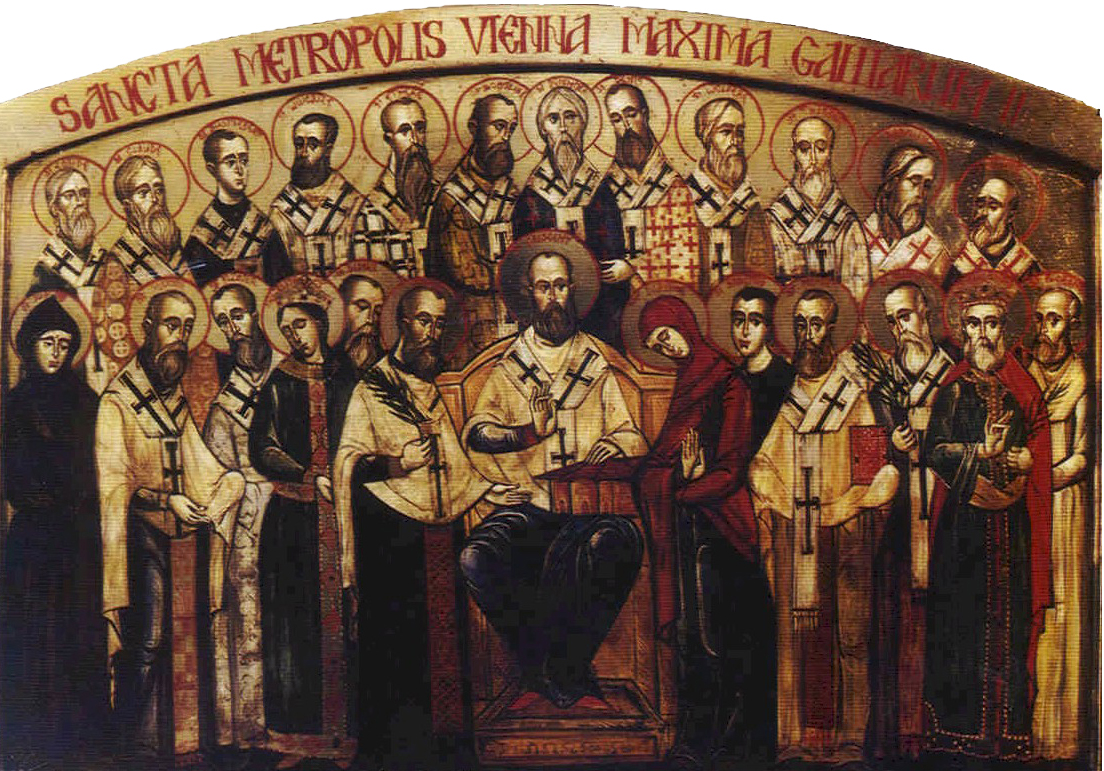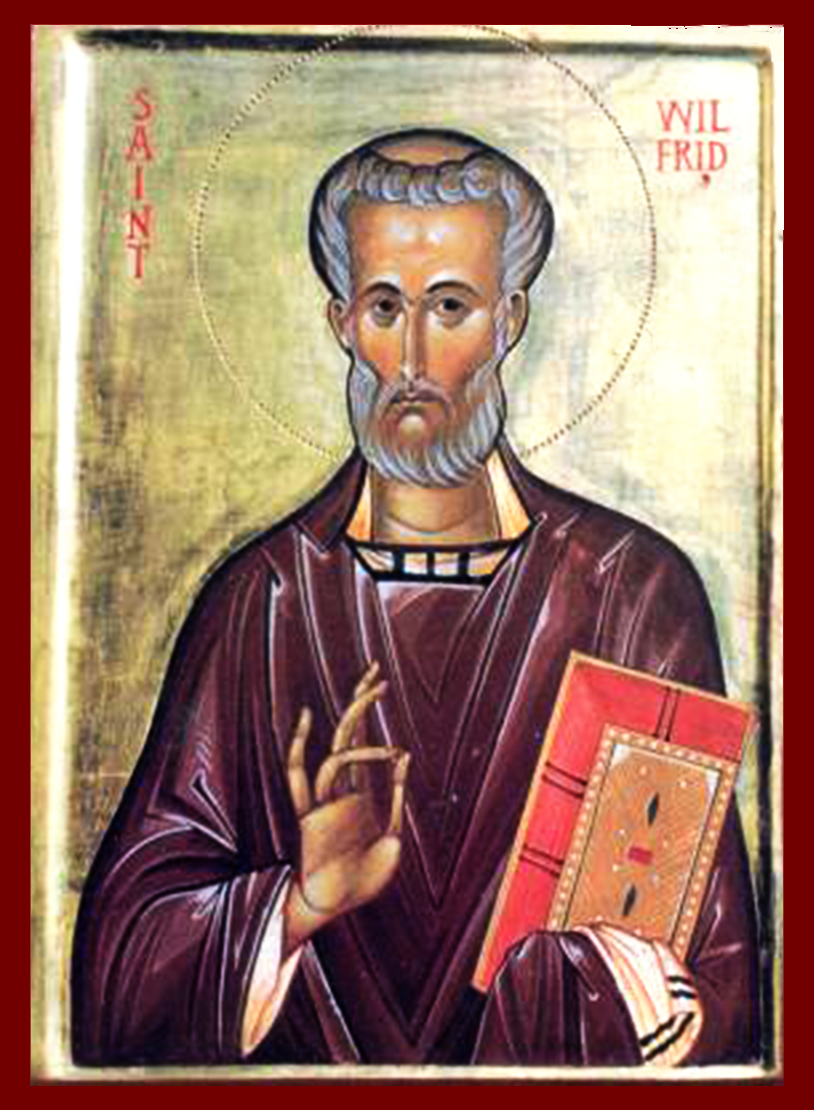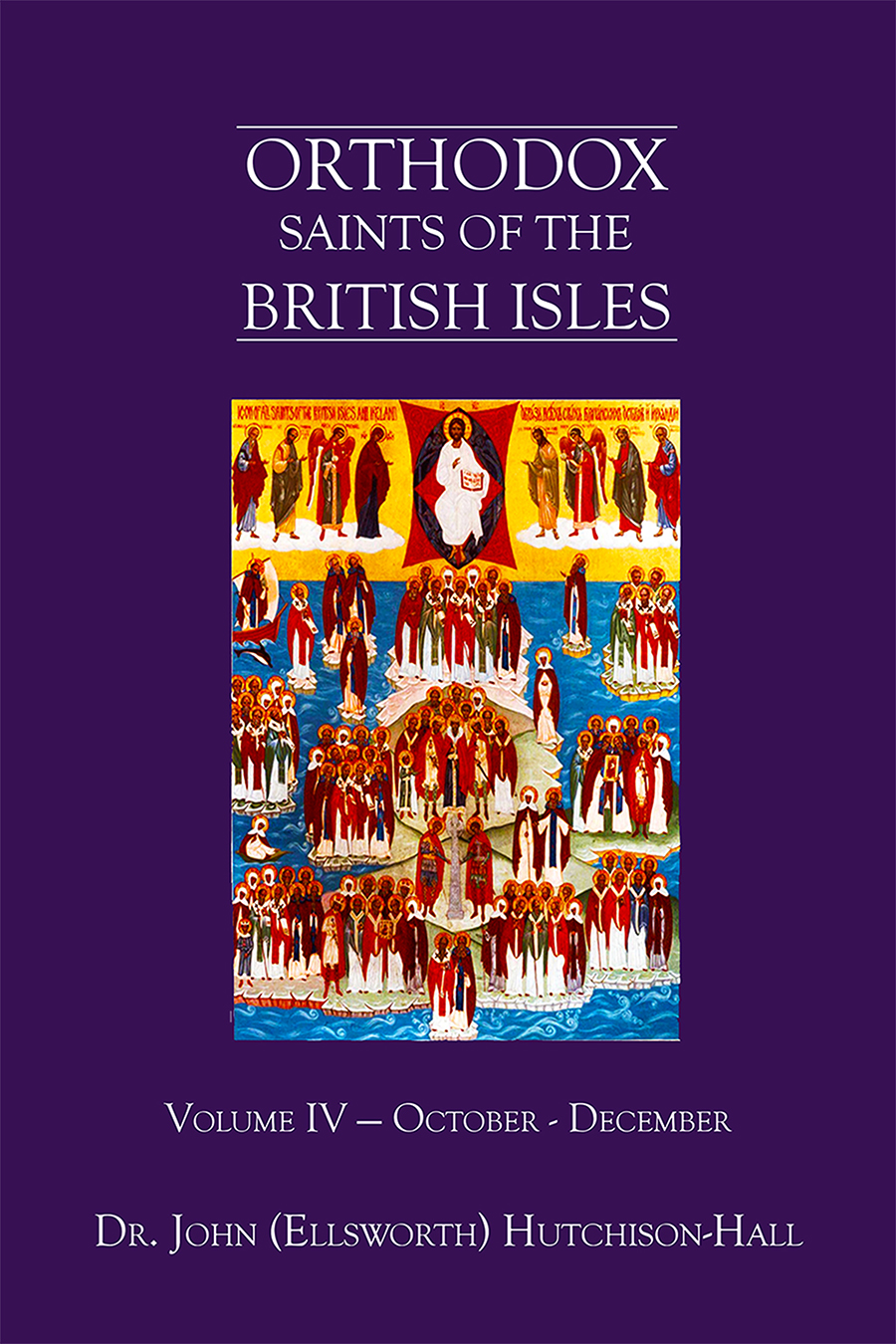
Orthodox Saints of the Pre-Schism
See of Rome
25th October (NS) — 12th October (OS) 2024
Icon of The Holy, Glorious, Right-Victorious Martyr, and Right-Believing King Eadwine (Edwin) of Northumbria
EADWINE (EDWIN, ÆDUINI) of NORTHUMBRIA, king of Northumbria (r. 616–633) was born circa 584, the son of Ælla, King of Deira (r. c. 560–?). St. Eadwine married St. Æthelburh of Kent (8th September), the daughter of England’s first Christian king, St. Æthelberht (24th February), King of Kent (r. 560–616), circa 625. St. Æthelburh was accompanied to Northumbria by her chaplain, St. Paulinus of York (10th October), and though St. Eadwine didn’t initially convert, he did not obstruct SS. Æthelburh and Paulinus as they practiced the faith and allowed his daughter Eanflæd to be baptised. According to St. Bede the Venerable (25th May) King St. Eadwine and his chieftains were baptised on 12th April, 627. Following his baptism, St. Eadwine appointed St. Paulinus Bishop of York, and commenced the building of a stone church there. However, his plans were thwarted by the invasion of Northumbria by Penda of Mercia, and his ally, Cædwalla of Gwynedd. The two armies met at Hatfield Chase (near present-day Doncaster, South Yorkshire), on 12th October, 633 resulting in the rout of the Northumbrians, and St. Eadwine’s death. The body of King St. Eadwine was buried at Whitby Abbey, sans head, which was enshrined at York. Following his repose, St. Eadwine was quickly venerated as a saint, and most early English calendars list him as a martyr.
EDISTIUS of RAVENNA, there is no documentary information on St. Edistius extant. All the traditions agree he was martyred in Italy, most say Ravenna, either circa 60 or 303.
EVAGRIUS the MARTYR, PRISCIAN the MARTYR, and COMPANIONS, (Date Unknown), an unknown number of martyrs. Sources differ as to location, some state Rome others Syria.
FELIX and CYPRIAN, according to a contemporary account by Victor of Utica, SS. Félix and Cyprian were bishops in northern Africa, who along with close to five thousand fellow Christians, including many young children, were tortured then driven out to the Sahara Desert and left to starve. This was done circa 482 during the persecutions by the Arian Huneric, King of the Vandals (r. 477–484).
FIACE (FIECH), (Fifth Century), St. Fiace was a friend and disciple of St. Patrick of Ireland (17th March), and was bishop of an unknown See. He is the author of a still extant hymn in honour of St. Patrick.
HERLINDIS and RELINDIS (RENILDIS, RENULA, RENULE), following the completion of their education, SS. Herlindis and Relindis received monastic tonsure and entered Aldeneik Abbey, at Maaseik on the Meuse in present-day Belgium, which had been built for them by their father, a Frankish nobleman. St. Herlindis served as first Abbess of the community until her repose circa 745 and was succeeded by her sister St. Relindis as the second abbess who reposed circa 750.
MAXIMILIAN of CELEIA, following the death of his parents, St. Maximilian freed his family’s slaves and gave his wealth to the poor, and then went on a pilgrimage to Rome. Whilst in Rome he was commissioned by Pope St. Sixtus II (6th August) to evangelise Noricum and Pannonia. Having achieved impressive results in his missionary labour, St. Maximilian was ordained to the priesthood, and later consecrated Bishop of Laureacum (Lorsch, Hesse, Germany). During a visit circa 281 to his hometown of Celeia (modern Celje, Slovenia) St. Maximilian was arrested and beheaded for refusing to offer sacrifices to pagan gods. His relics have been enshrined in Passau (Lower Bavaria, Germany) since the eleventh century St. Maximilian is the patron saint of the Dioceses of Passau and Linz (Austria), as well as the Habsburg family.
MOBHÍ of GLASNEVIN (MOBHÍ CLÁRAINECH, BERCHÁN), St. Mobhí of Glasnevin is one of the Twelve Apostles of Ireland, and the founding-Abbot of the monastery of Glasnevin, Co. Dublin, Ireland. The noted 17th century hagiographer and historian John Colgan O.F.M. (†c. 1657) calls St. Mobhí, St. Berchán, and says he was a relative of St. Brigid of Kildare (1st February). At its height, there were about fifty students at Glasnevin, including SS. Columba of Iona (9th June), Comgall of Bangor (10th May), Ciarán of Clonmacnoise (14th June), and Canice of Aghaboe (11th October). It was St. Mobhí who, with his last breath, blessed St. Columba to found the School of Derry. Clárainech, which means “flat faced” in Irish Gaelic, is a reference to his being born without eyes or a nose. According to tradition he was miraculously cured upon splashing the baptismal water of St. David of Wales (1st March) on his face three times. In 544, a plague came through the area and the students dispersed to various parts of Ireland. St. Mobhí unfortunately succumbed to the plague and reposed on 12th October, 544, and soon after was recognised as a saint by his former disciples. The Martyrology of Donegal commemorates him as follows: “Mobhí Clárainech, abbot, of Glass Naoidhen, in Fine-Gall, on the brink of the river Lifè, on the north side; and Bearchán was another name for him”. Today there is a Church of Ireland parish in Glasnevin named for Saint Mobhí.
MONAS of MILAN, a Bishop of Milan (north-west Italy) of whom almost nothing is known about his life and episcopate. It seems he served from 193 until his repose in 249, though there are sources that place him as bishop approximately a century later.
PANTALUS of BASLE, (Date Unknown – Possibly Fifth Century), the first or second Bishop of Basle (north-western Switzerland). St. Pantalus is commemorated as a martyr.
SALVINUS of VERONA, a Bishop of Verona (northern Italy), known as a learned Prelate and for his holiness. St. Salvinus reposed 562, his relics are enshrined in the church of St. Stephen in Verona.
WILFRID (WALAFRIDUS, WILLFERDER) of YORK, a cosmopolitan Churchman, notable missionary, great defender of Papal authority, and one of the most celebrated, and controversial bishops of the Anglo-Saxon Church. St. Wilfrid entered Lindisfarne whilst still in his teens. However, he soon grew discontented with the Celtic practices there. With the goal of expanding his knowledge, especially of the Roman practices, St. Wilfrid spent time at Canterbury and Rome, returning via Lyons (east-central France) where he spent three years, receiving monastic tonsure according to the Roman practice. Upon his return to Britain, St. Wilfrid was made Abbot of the newly founded Ripon Abbey (North Yorkshire, England), where he introduced the Benedictine Rule. St. Wilfrid served as the chief spokesman for the Roman side at the Synod of Whitby, where his erudition served him well and as a result was able to persuade the Council to adopt the Roman practices.
St. Wilfrid made such a mark at the Council that he was elevated to the See of York. However, St. Wilfrid declined to be consecrated by the Northern bishops, who followed the Celtic practices, and hence he considered schismatics. Therefore, St. Wilfred travelled to France where he was consecrated by twelve Frankish bishops at Compiègne (northern France). For reasons no longer known, his sojourn in France was longer than anticipated, and in his absence St. Ceadda (2nd March) was appointed in his place. Upon his return in 666, St. Wilfrid, in great humility, accepted St. Ceadda as bishop and retired to Ripon. A few years after St. Wilfred’s return, St. Theodore of Canterbury (19th September), visited Northumbria, where he found St. Ceadda working as bishop. He pointed out to him the defects of his position and, at his instigation, St. Ceadda withdrew, and St. Wilfrid was finally installed as Bishop of York in 669. During his tenure as bishop, St. Wilfrid acted with great vigour, enforcing the Roman practice amongst the Celtic monks, founding churches and monasteries, and completely rebuilt the minster at York. Not a decade later St. Theodore divided the Diocese of York into three sees without St. Wilfrid’s consent, resulting in St. Wilfrid appealing to Rome. Though he prevailed in his appeal, on his return to England he was imprisoned, and then exiled to Sussex, where he carried out successful missionary work (681–6). After reconciling with St. Theodore of Canterbury St. Wilfrid was reinstated to the See of York, which he held for about five years before disputes with Aldfrith, King of Northumbria (r. 685–704/5) compelled him to flee yet again. St. Wilfrid was then invited by the King of Mercia to administer the vacant See of Lichfield (Staffordshire, England). In 703, a synod called by St. Brithwald of Canterbury (9th January), the then Archbishop of Canterbury, decreed that St. Wilfrid should resign his See and retire to Ripon. Once more St. Wilfrid appealed to Rome, and once more his claims were upheld. However, in humility, St. Wilfrid agreed, to resign in favour of St. John of Beverley (7th May), accepting instead the See of Hexham (Northumberland, England), and spending the last years of his life in his monastery at Ripon, reposing in 709. St. Wilfrid’s feast is listed on the calendar of the Moscow Patriarchate on 24th April, as well as 12th October.
Get your copy of Orthodox Saints of the British Isles today.
Available at Amazon or your favourite e-bookstore.
CHRYSANTHUS and DARIA, Husband and wife natives of Egypt, but living in Rome. They were quite public about their faith in Christ. Martyred during the reign of the Emperor Numerian (r. 283–284).
CRISPIN and CRISPINIAN, Roman missionaries in the area around Soisson in present-day France. Beheaded at Soisson circa 285–287, their cultus enjoyed great popularity in the Middle Ages, as memorialised by Shakespeare in King Henry’s address to his troops prior to the Battle of Agincourt (Henry V Act IV Scene iii). The later Roman Martyrology in which the Feast of the Martyrs SS. Chrysanthus and Daria (vide supra) took precedence, led to the liturgical celebration of their feast being superseded. SS. Crispin and Crispinian supported themselves as shoemakers, and are the Patron Saints of shoemakers, saddlers, and tanners. They are often said to have been brothers, and possibly members of the Roman Nobility, though there is no evidence to support this.
CYRINUS of ROME, a victim of the Diocletianic Persecution (303–313).
DULCARDUS (DOULCHARD), a monk at the Abbey of Saint-Mesmin (Abbaye Saint-Mesmin de Micy), in Micy near Orléans (north-central France). St. Dulcardus spent the last years of his life as a hermit in what later became the village of Saint-Doulchard, just north-west of present-day Bourges, France. St. Dulcardus reposed in 584.
FRONTO of PÉRIGUEUX and GEORGE of PÉRIGUEUX, according to the Martyrology of Ado (circa 858), and the 1914 edition of the Roman Martyrology St. Fronto, a bishop, was baptised by the Apostle Peter (29th June) and then sent, along with St. George, a priest, to preach the Gospel in Périgueux (south-western France) and the surrounding area, and at some point consecrated the first Bishop of that See. According to some later traditions St. George was the founder of the church at Le Puy-en-Velay (southern France). According to some hagiographies (circa 10th–13th century), St. Fronto flourished in the mid- to late-third century and was dispatched to Périgueux to help the Christian community there recover from the Decian Persecution (250–251).
FRUCTUS (FRUTOS) of SEGOVIA, a pious Christian who lived in Sépulveda in Castile (north-western Spain). Following the martyrdom of his brother and sister SS. Valentine and Engratia (26th October) at the hand of the Moors circa 715, St. Fructus fled, and lived as a hermit until his repose of natural causes later the same year. His relics, along with those of his siblings, are enshrined at Segovia north-west of Madrid. Their feast is still celebrated on the week-end closest to the 25th of October by the community of Aguilafuente (north-western Spain).
GAUDENTIUS of BRESCIA, the successor to St. Philastrius of Brescia (18th July) as Bishop of Brescia in Lombardy (northern Italy), receiving consecration at the hands of St. Ambrose of Milan (7th December) circa 387. St. Guadentius reposed somewhere between 410 and 420. We are fortunate that some of his sermons, including ten of his Easter sermons, have survived.
GOEZNOVEUS of LÉON, a native of Cornwall (south-west England), St. Goeznoveus went to Brittany (north-western France) and was later consecrated Bishop of Léon (south-western France. He reposed in 675.
GUESNOVEUS (GOUERNOU) of QUIMPER, a Bishop of Quimper in Brittany (north-western France), and founder of a monastery of some renown near Brest in Brittany. St. Guesnoveus reposed at his monastery in 675.
HILARY of JAVOLS, (Sixth Century), one of the last Bishops of Javols (southern France) before it was subsumed by the Diocese of Mende (southern France). There is no further information on his life extant.
HILARY of MENDE, an adult convert who lived as a hermit on the banks of the River Tarn in southern present-day France. St. Hilary built a monastery for the disciples who joined him, but then left to live at the Abbey of Our Lady of Lérins (abbaye Notre Dame de Lérins) on one of the Lérins Islands in the Mediterranean Ocean off the Côte d’Azur in France to gain better knowledge of their monastic rule. Returning to his monastery, he was consecrated Bishop of Mende (southern France). St. Hilary reposed in 535.
HILDEMARCA, St. Hildemarca was Abbess of St. Eulalia Abbey (abbaye de Sainte-Eulalia) in Bordeaux, when St. Wandrille of Fontenelle (22nd July) appointed her to serve as Abbess of the new Abbey of the Trinity of Fécamp (Abbaye de la Trinité de Fécamp). St. Hildemarca reposed circa 670.
LUPUS of BAYEUX, fourth Bishop of Bayeux in Normandy (north-western France) (circa 434–464). No further information is extant.
MARTYRS of ROME, a group of forty-six soldiers and twenty-one civilians martyred in Rome in 269, during the reign of the Emperor Claudius II (r. 268–270).
MINIATO (MINIAS), often called the Protomartyr of Florence in Tuscany (central Italy), St. Miniato was a soldier stationed in Florence who energetically evangelised his fellow soldiers. St. Miniato was martyred during the Decian Persecution (250–251). It is said St. Miniato was subjected to extreme torture prior to his execution. The Basilica of San Miniato al Monte in Florence is dedicated to him.
PROTUS of SASSARI and JANUARIUS of SASSARI, Ordained by Pope St. Caius (22nd April), Protus to the priesthood, and Januarius to the deaconate, the saints laboured to evangelise their native Sardinia. Whilst their work was quite fruitful, they were martyred by decapitation at Porto Torres on the north-west coast of Sardinia during the Diocletianic Persecution (303–313).
THEODOSIUS of ROME, LUCIUS of ROME, MARK of ROME, and PETER of ROME, of a group of fifty soldiers martyred in 269 at Rome during the reign of the Emperor Claudius II (r. 268–270), only the names of these four saints are known to us.
Prior to the Schism the Patriarchate of Rome was Orthodox, and fully in communion with the Orthodox Church. As Saint John of Shanghai and San Francisco +1966 said “The West was Orthodox for a thousand years, and her venerable Liturgy is far older than any of her heresies”.
Details of British Saints excerpted from Orthodox Saints of the British Isles.
Details of continental saints from these sources.
In many cases there are several spelling versions of the names of saints from the British Isles. I use the Oxford Dictionary of National Biography version as the primary version with the more prevalent version in parenthesis e.g. Ceadda (Chad) of Lichfield.


